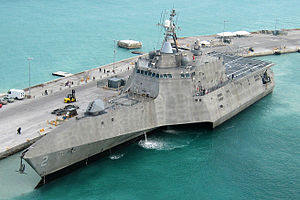!!PLANET EXCLUSIVE!! LIGHTS OUT FOR TAXPAYERS ON NAVY’s FAILED LCS SHIPS … GENERAL DYNAMICS AXED 50 JOBS COULD BE A HINT OF FUTURE PASSED FOR PITTSFIELD WORKERS … ACTIONS AND RAMPANT SPECULATION PART OF DISASTROUS, COSTLY, NON-FUNCTIONAL LCS PROGRAM … ARE HUNDREDS OF PITTSFIELD JOBS NEXT?
By DAN VALENTI
PLANET VALENTI News and Commentary
(FORTRESS OF SOLITUDE, WEDNESDAY, SEPT. 26, 2012) — “Everybody’s got a plan until they get punched in the mouth” — Mike Tyson.
“You don’t get to see the actual report itself, of course, even though you’ve paid for the ships and the contractors — twice — who phoned in their work here. It’s possible the congressional anger that LCS stirred up earlier this year could result in more disclosures about what the Navy has learned, but do not hold your breath for that.” — Philip Ewing, on the LCS program that forms a large part of the General Dynamics business in Pittsfield.
True. Everything looks great on the flip chart. Prior to the first snap in the game, every coach’s game plan results in victory.
On the flip chart, employment remains stable and everyone gets to keep their job. In the real world, and especially in the Dreaded Private Sector, employment levels reflect the marketplace. When demand goes down, as the Defense Department’s did for special armor and guns, jobs get cut, as General Dynamics did at facilities in Williston, Vt., and Saco, Maine. In the public sector, of course, no one ever loses a job, regardless of what the market is doing.
Behind the General Dynamics story, a much bigger one may be in the making at the Pittsfield GD plant on Plastics Avenue: Are hundreds of jobs on the chopping block? One GD source, speaking on strict condition of anonymity, says just that.
What’s Not to Love About War and Rumors of War?
What press reports left out of the General Dynamics story in Maine and Vermont is the employment situation at the GD facility on Plastics Avenue in Pittsfield. First, though, a little background may help to explain and put the story in proper perspective.
GD designs, engineers, and manufacturers combat vehicles and systems, arms, and munitions for various customers, including, of course, the U.S. Defense Department. As a business, GD loves war and rumors of war, because it’s good for the bottom line. Companies like GD, with a vested interest in war mongering, have kept the United States in a perpetual state of war since the end of World War II (Cold War, Korea, Vietnam, Grenada, Desert Storm, Iraq, Afghanistan, the War on Terror, ad infinitum, ad nauseum).
In this warped, self-perpetuating War Machine, politicians love war because as Commanders in Chief have known since the days of Washington, when the country is at war, it’s easy to rally in support. Why else, for example, did that disaster of a president, George “What, Me Worry?” Bush count Sept. 11, 2011 as his lucky day? Mr. Mission Accomplished got the nation into two police actions that have cost hundreds of thousands of lives, millions of wounded, and trillions of U.S. tax dollars.
In Pittsfield, GD works on, among other things, the Navy’s littoral (close to shore) ships (LCS), dubbed the “Corvettes of the Navy” for their sleek design, speed, and stealth capabilities. They’re great to look at, like something from a Marvel comic book, but the ships have one tiny problem: They can barely stay afloat.
Problems Right from the Get Go
The LCS program has been plagued with trouble since the beginning. After getting by for 230 years with these “Corvettes,” the Navy decided it needed them. As Mike Tyson said, though, things drawn up on the flip chart tend to fall apart after that first rap in the mouth. GD’s initial contracts in 2007 to build these ships were canceled because of its inability to control cost overruns.
In fact, in 2008, in his presidential campaign, Sen. John McCain used the failed LCS as an example of the waste of taxpayer money. Four years ago to this day, in a debate with Barack Obama, McCain mentioned the LCS. He sneezed, and everyone who was banking on the program, including GD execs in Pittsfield, caught cold. There was no reason to fear, of course, since after Obama won, he didn’t dare go up against the Military-Industrial Complex. The LCS program lived.
Not to worry. McCain lost, and under President Barack Obama, Navy secretary Donald Winter sought out rebids for the LCS program. In reviving a program that had no actual need, no behind the scenes lobbying or tete-e-tetes in smoke-filled, back-house room were conducted, we gather, in the same way that no politicians, well-placed officials, and other decision makers would ever consider inducements in the form of bribes. It didn’t matter that for Navy Secretary John Lehman blasted the revival of an unneeded program. Lehman argued before Congress that without a price cap on the contracts, taxpayers would get hosed.
The caps were rejected. The hosing took place.
The Prices Go Up, Up, Up … the Value Goes Down, Down Down
Lehman argued that a common-design for all LCS ships would allow them to be built to for about $220 million apiece. Price caps were rejected. The first ships commissioned were expected to cost $460 million. FY10 budget documents from the General Accounting Office show that the cost of the USS Freedom has jumped to $637 million and $704 million for the USS Independence (source, NY Times article, May 8, 2012). By the following fiscal year, the cost per ship was guesstimated at $1.8 billion for a total program cost of $3.7 billion. What’s a few hundred million among friends?
On the question of performance, the story gets worse. In an article on Department of Defense Buzz, July 24, 2012, Phillip Ewing reported that the ships “haven’t turned out as hoped.”
The following is excerpted from Ewing’s article:
—– 00 —–
As Defense News’ naval man Christopher P. Cavas has revealed in a series of extraordinary reports, the bottom has dropped out of the LCS stock inside the service, which quietly worries the ships can’t do several of the key things for which they were designed: Deploy with small, highly expert crews; quickly and easily swap their mission equipment in foreign ports; or keep the ships in fighting shape on an extended voyage at sea.
Cavas’ latest report references an internal Navy study that found it’ll be more difficult than anyone thought for LCS crews to do maintenance on deployment. They rely on American contractors who must fly in to help. U.S. law prohibits foreign workers from doing the kind of work LCS needs — a fact that, incredibly, seems to have escaped Navy leaders despite the years and billions they’ve spent on the program. This means taxpayers must pay for a team to fly from the U.S. to meet an LCS in, say, Busan, South Korea, to help the crew with the ship’s upkeep.
The limited ability of the LCS crew to perform onboard maintenance, and the need to return to port for even basic repairs, “negatively impacts” the ships’ availability to operational commanders, according to sources familiar with the classified report.
Further, the contractor teams handling maintenance duties are not performing up to snuff or being held accountable for their work. Many contractors are doing the work twice — the second time to correct problems with their initial work — avoiding penalties and billing the Navy twice for the jobs.
According to some LCS crews, the reliance on contractors actually results in more work for the crew, which is too small to supervise the contractors. Navy sailors often have to fix the problems after the contractors have left.
Extensive contractor services also are required to maintain spare parts inventories for the ships, since each of the two ship designs features a number of non-standard systems and the vessels are too small to carry many spares. Ships will be based on either the Lockheed Martin Freedom-class design or Austal USA’s Independence class.
But the reports note the parts and work requirements need to be identified and ordered well in advance, so they’re available when needed — a situation that severely limits the flexibility of the LCS.
You don’t get to see the actual report itself, of course, even though you’ve paid for the ships and the contractors — twice — who phoned in their work here. It’s possible the congressional anger that LCS stirred up earlier this year could result in more disclosures about what the Navy has learned, but do not hold your breath for that.
As for now, the Navy has already conceded it’s adding 20 more racks to its LCS the USS Freedom, and in another Cavas report, that LCS can’t take many of the missions the Navy needs and can’t do the relatively quick toe-touch port swap of mission modules that was to have been its ace in the hole. In that story, Cavas wrote this:
The shortcomings are well known in the fleet, prompting a perception that service leaders are looking for missions to fit LCS, rather than the other way around.
And in Monday’s story, he wrote this:
The OPNAV report, according to sources, concluded that, in light of what the ships can and can’t do, the entire LCS concept of operations needs to be reviewed, along with the minimal-manning requirements and the contractor-based maintenance schemes.
The studies make plain the Navy’s concern with exhaustion and fatigue among LCS crews and the need to improve their quality of life, and cite “the reality of the workload” to bolster those positions.
The review efforts also highlight the extreme complexity of the LCS program — the multiple crews, additional mission module packages and aviation detachments, and two distinct ship classes — as major factors in developing solutions.
So: The Navy has boxed itself into a program that it apparently cannot execute as it once planned. Despite years of criticism and skepticism from the outside, the service is at last reaching this conclusion for itself. Its leaders are acknowledging the need to take another look. Which makes the next question: Where could LCS go now?
Maybe Norman Polmar will win his dollar bill and the Navy will not order any more ships. Ending the current run at 22 vessels, instead of 55, could let the fleet field more sailors per ship and get more good out of each — “wholeness” being a favorite goal of Adm. Jonathan Greenert, the chief of naval operations. Building fewer ships also could theoretically free up money to better equip them, since it appears the Navy may be forced to rely more than it first wanted on built-in weapons and equipment, as opposed to the interchangeable gear.
(Cavas wrote that Navy leaders have acknowledged they’re looking at installing Harpoon anti-ship missiles and a 76 mm gun, to upgrade from today’s 57 mm — though the larger gun may not fit onto the Independence-class ships’ narrow bow.)
It’s not difficult to imagine the Navy dividing up its smaller but fully manned LCS fleet into dedicated squadrons with permanent missions. Some ships could be rigged for surface patrols, others for mine countermeasures and others for anti-submarine warfare. The Navy would get some of the ships it says it needs, though sacrificing each individual ship’s ability to be a wild card.
The Navy brass, under its LCS-Is-A-Phish-Concert Doctrine — nobody knows where the groove will take us, bro! — would probably say the beauty of the program is its ability to accept these changes. The challenge is that LCS can only change so much; the ships are what they are, and altering them too much, to improve their endurance or increase their size, would spoil the progress of the Navy and its vendors in reducing their costs as they have. Whatever the heirs of the Freedom and Independence become, they probably cannot be true frigates or destroyers. Wrote Cavas:
Range is still another concern, because of capacity for both fuel and crew provisions. Although the original [concept of operations] called for ships to operate at sea for at least 21 days, the ships have storage capacity to only carry enough food for 14 days, according to sources familiar with the classified report.
So LCS could become something other than LCS we thought we’d get, but the ships that today’s Navy is inheriting may only be able to do so much.
—– 00 —–
So much for Mary Jane and Joe Kapanski, who again get screwed. The GD workers in Pittsfield who have found employment because of the LCS turkey would do well to engage in some serious soul searching: Not only are they helping to build machines designed for killing, they are building them at a ruinous cost to taxpayers as well as building products that will not perform as the flip chart says. We understand the power of the Almighty Dollar and the need to hold onto a job, but at what cost? What person of well-formed conscience would work under these conditions?
Maybe the issue will be decided for them. The congressional anger referred to in Ewing’s article could yet translate into a call for scrapping the entire program. Already, according to a source who works at GD in Pittsfield, rumors are swirling around the water cooler that many of the 500 jobs created by this boondoggle program will be gone by December 2013.
The source says that presidential challenger Mitt Romney has little love for the LCS and would eagerly embrace any program that could be cut that would (a) save taxpayer billions and (b) wouldn’t be missed. An Obama win probably means the LCS gets a powder for another four years.
The source, who has attended fundraiser for both Elizabeth Warren and Scott Brown, says Brown wants to see the program go and Warren would work to keep it in place: “I don’t think she really cares but she would definitely vote to keep it if the White House or other ranking Democrats told her to do so. With Brown, he’s more his own man. He’s a fiscal conservative, and while he would not want to see jobs lost, he would probably make the tough call and save taxpayers the money.”
We can only hope.
———————————————————————–
BOYS IN FIERY BANDS TO TIGER LEAD, WHOLE THE STEER AND THE LION, AT ONE CRIB, SHALL MEET.
“OPEN THE WINDOW, AUNT MILLIE.”
LOVE TO ALL.
















Granny Warren wil do exactly what she is told. Just like Trisha Blah-Blah.
Heard about these talks of big job cuts next year from a friend of mine who works as GD. Good expose of the LCD program DV. Youre top investigative journalist in W Mass.
As most of the 500 jobs promised for Pittsfield at GD were actually in Kentucky and Tennessee anyhow, it’ll be people who’ve been here from before this all started who get cut. ruberto and barrett and all the other people who took credit for these phantom jobs, where are they now an d will they take credit for their departure too? I doubt it, people like them are only available for pictures and interviews when the news is supposedly good.
The government currently spends more money on defense since the Cold War. Denfense contractors are making more money now than ever. It’s easy to layoff workers as they are more proficient with less.
Defense!
Mitt Romney will continue “defense” spending that’s how he’s going to create jobs. By keeping us the most powerful military in the world.
Everyone is for cutting military spending, unless it is in there district.
We should cut private/para military spending but keep our actual military strong. It’s pretty stupid to out source jobs our guys are trained to do only to have them redo the work done by a private company.